
* The F-16 has not only become a major weapon in the US inventory, it has also been exported to dozens of other countries. This chapter describes the career of the F-16 in US and foreign service.
* Through the 1980s, the US Air Force built up their stocks of F-16s, deploying them at home and overseas. By the early 1990s, the USAF had obtained over 2,200 machines, almost half of total production. USAF F-16s didn't see much in the way of combat for about the first decade of their existence, though they were involved in combat in Pakistani and particularly Israeli hands during that time, as discussed later.
The Gulf War in 1991 was the first major action for USAF F-16s. The F-16 was assigned to the attack role during the Gulf War and scored no "kills" against Iraqi aircraft, but the F-16s performed large numbers of strikes on ground targets and also flew "Fast FAC (Forward Air Control)" missions to spot targets for other strike elements. Three F-16s were lost in combat and one was lost in an operational accident during the conflict.
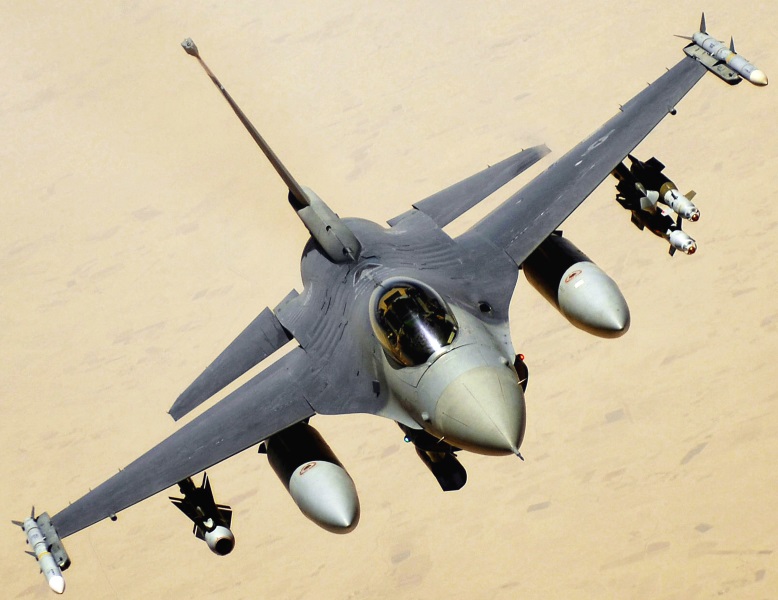
After the war, the F-16 flew combat air patrols over the northern and southern "no fly zones" in Iraq that had been set up under cease-fire conditions. The Iraqis were told to not fly aircraft in these areas, and if they did the aircraft were fired on. This led to the first USAF F-16 "kill" on 27 December 1992, when an F-16 pilot, Lieutenant Colonel Gary North, used an AIM-120 AMRAAM to shoot down an Iraqi MiG-25 Foxbat interceptor. This was the first combat use of AMRAAM. A month later, an F-16 shot down an Iraqi MiG-23.
USAF F-16s were very busy during various Western peacekeeping operations over the former Yugoslavia in the 1990s, generally flying out of Aviano Air Base in Italy. The F-16s on occasions performed strikes and, using the HARM Targeting System, defense suppression. They also got involved in air combat. On 28 February 1994, USAF F-16s then shot down four Bosnian combat aircraft during the Operation DENY FLIGHT effort over Bosnia. Three were shot down by USAF Captain Robert "Wilbur" Wright, with one destroyed by an AMRAAM and two by Sidewinders. Incidentally, pictures of Wright showed him to be a photogenic sort who looked exactly like the Hollywood idea of a fighter pilot.
Wright's wingman, Captain Scott O'Grady, had some excitement of his own when he was shot down by a Serbian SA-6 SAM over Bosnia on 2 June 1995. The adventure in which he evaded capture for six days and was recovered by search and rescue teams was played up in the media. Wright's triple-victory was downplayed for security reasons.
F-16s are also well-represented in the US Air National Guard, and USANG units have on occasion deployed overseas to participate in combat and peacekeeping actions. Stateside, USANG F-16s often served in the continental air-defense role, which seemed to be in decline after the fall of the USSR in the early 1990s. However, the attacks by Islamic terrorists on the United States on 11 September 2001, in which hijacked airliners were flown into the World Trade Center and the Pentagon, led to a resurgence in continental air-defense activities, and USANG F-16s have been heavily tasked on air patrols to protect American cities.
F-16s also flew combat missions during the US intervention in Afghanistan in 2001:2002 that followed the 11 September attacks, and in the American invasion of Iraq in the spring of 2003. 24 ANG F-16s, operating discreetly from Jordan, performed 700 sorties during the US invasion of Iraq in the spring of 2003, hunting for Scud missiles that could be fired on Israel from western Iraq, and also providing strike support for ground forces. From 2015, F-16s performed strikes on Islamic State insurgents in Iraq and Syria -- the F-16s including not only USAF machines, but those of other F-16 operators like Jordan and Poland.
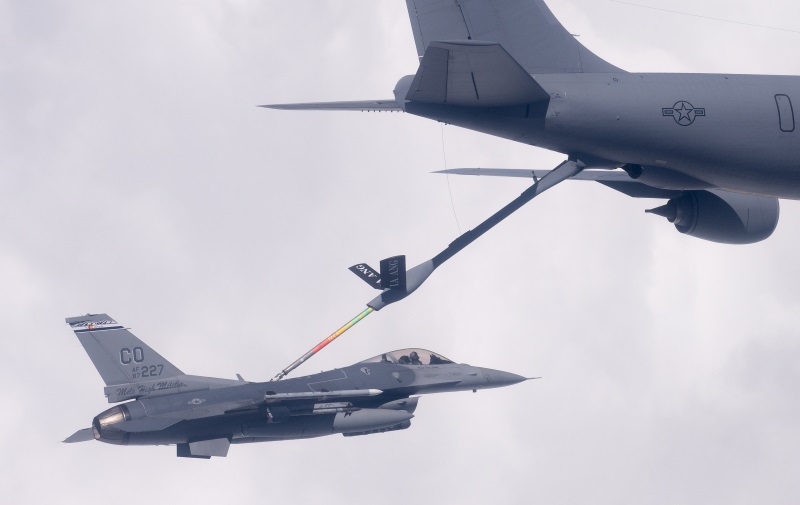
The last of 2,231 USAF F-16s was delivered on 18 March 2005, over a quarter of a century after the initial delivery. Only about half that number remain in US service, with the fleet continuing to shrink. All F-16s now in first-line USAF use are Block 40/42 or later machines; earlier variants have been or are being retired.
In recent years, the Air Force has been working on a scheme known as "Agile Combat Employment (ACE)", the idea being to deploy aircraft to a variety of forward locations, many of them remote or austere, with minimal support. One of the problems with the F-16 with regards to ACE is that F-16 pilots, unlike A-10 or F-35 pilots, need a boarding ladder to get in and out of the cockpit -- and getting the boarding ladders to a remote location is troublesome. In consequence, Air Force personnel have devised a folding boarding ladder that fits inside the cockpit map case. Not much else has been said about ACE; more should be revealed in time.
BACK_TO_TOP* As mentioned earlier, even before the flight of the first production F-16 foreign users were interested in obtaining the type. Belgium, Denmark, the Netherlands, and Norway formed a group in 1974 to consider adopting the winner of the LWF competition as a replacement for their Lockheed F-104 Starfighters. This led the four-nation group to announce their intent to obtain a total of 348 F-16s on 7 June 1975. The deal was called with good reason the "sale of the century". Some minor changes were made to the baseline F-16 design to accommodate European needs, though the Europeans didn't get all the changes they asked for.
The machines were to be provided by General Dynamics in kit form for assembly in Europe. The prime contractors were Fokker in the Netherlands, which was to build a total of 184 machines for the Netherlands and Norway, and SABCA in Belgium, which was to build a total of 164 for Belgium and Denmark. Subsystems and assemblies were built by firms all over Western Europe. For example, the P&W F100 engine was assembled by Fabrique Nationale in Belgium, while MBLE in Belgium built the AN/APG-66 radar. Some European assemblies were used in US production, as dictated by the terms of the international manufacturing deal.
In 1977, USAF Brigadier General James Abrahamson, in charge of the worldwide F-16 program, described the logistics of setting up international production as a "management nightmare". Along with the simple, monster problem of just getting all the nuts and bolts collected and assembled into flying machines -- made all the worse because European production was being brought up in parallel with American production -- there were cultural differences to consider. European firms tend to have more inflexible work rules than American firms, which had the result of making European-built F-16s about a million USD more expensive than their American equivalents. The European firms also took 50% longer to get them out the door.
Whatever the problems, things were made to work. The European production lines opened in the spring of 1978, with the delivery of a sample F-16A to SABCA in June. The first European-built F-16, a SABCA-built F-16B, performed its initial flight on 11 December 1978. Service deliveries began on both sides of the Atlantic in January 1979.
* The Belgians obtained a total of 160 F-16A/Bs, including 136 F-16As and 24 F-16Bs, in Blocks 1, 5, 10, and 15. The last Belgian F-16s were delivered in 1991. All the Block 1 and 5 machines were upgraded to Block 10.
Belgian machines were fitted with an ESD Carapace ECM unit, featuring antennas on the sides of the engine inlet, and a brake chute. The brake chute was not included in early production but was retrofitted. The Belgian Air Force also evaluated the Matra Magic 2 AAM as an alternative to the Sidewinder, but the French missile was not adopted as a standard weapon. A number of Belgian F-16s were fitted to carry the Oude Delft Orpheus reconnaissance pod on a centerline pylon, with the Orpheus pods later replaced in service by the more modern Danish Terma Modular Reconnaissance Pod (MRP).
In 1993, Belgium committed to upgrade their machines through the Mid-Life Upgrade program, with 72 aircraft updated to the MLU spec. The other surviving F-16s were either mothballed or sold off. Further updates have been applied to the surviving fleet since that time; Belgian F-16s now carry both the Sniper pod and the AIM-9X. Belgian F-16s have participated in combat operations in the Balkans, Afghanistan, Libya, and against Islamic State. Belgium is now acquiring the F-35; the Belgian F-16 force has now been reduced to 60 aircraft, with 21 sold to Jordan. Some unspecified number will be passed on to Ukraine.
* The Danes obtained a total of 70 new-built F-16A/Bs, including 54 F-16As and 16 F-16Bs. As with Belgian F-16s, Danish machines included Block 1, 5, 10, and 15 aircraft, with the Block 1 and 5 aircraft gradually brought up to Block 10 spec. Three ex-US ANG F-16As were obtained in 1994 as attrition replacements and brought up to a common spec with other Danish F-16s. Three more hand-me-down F-16As and one F-16B were obtained in the late 1990s. 61 Danish F-16s were upgraded through the MLU program.
Danish F-16s were fitted with the locally-built Terma PIDS chaff-flare dispenser built into a stores pylon. Some were also wired to carry a Red Baron reconnaissance pod on the centerline, or the better Terma "Modular Reconnaissance Pod (MRP)". Danish F-16s have participated in combat operations in the Balkans and Afghanistan. Denmark is now obtaining the F-35 and drawing down its F-16 force, with 19 to be passed on to Ukraine.
* The Netherlands obtained a total of 213 F-16A/Bs, including 177 F-16As and 36 F-16Bs, with the last delivered in 1992. As with the other members of the four-nation group, the F-16s were delivered in Blocks 1, 5, 10, and 15, with the Block 1 and 5 aircraft later upgraded to Block 10. The Block 15 machines were given the OCU upgrade in the early 1980s.
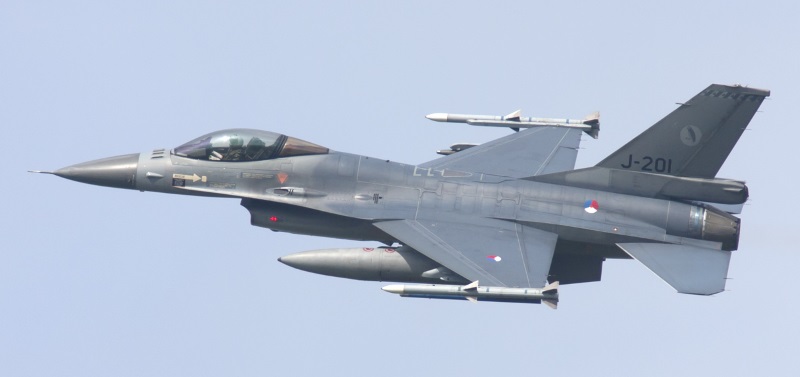
Dutch F-16s were mostly tasked with the close-support mission, but have also participated in peacekeeping air patrol operations in the Balkans, and participated in NATO operations in Afghanistan. A few Dutch F-16As were wired up to carry the Orpheus reconnaissance pod, and were known by the designation "F-16A(R)". The pod was originally carried on the F-104 Starfighter and included film cameras and an infrared linescanner; it was then replaced for F-16 carriage by the more modern "Medium Altitude Reconnaissance System (MARS)" pod, which in turn gave way in the 21st century to the Israeli Rafael "RecceLite" pod.
RecceLite, as its name implies, was a lightweight pod that is carried on the right stores pylon under the engine intake; it carried infrared and daylight TV imagers, with wide-angle and close-up capabilities, and could store imagery on an internal solid-state data recorder. It also had a datalink to permit near-real-time transmission of imagery to a ground station. Dutch F-16s were also equipped with the Rafael / Northrop-Grumman Litening targeting pod.
The F-16 is being phased out of Dutch service in favor of the F-35; it will be completely out of Dutch service by 2024. To date, 29 Dutch F-16s have been sold to Jordan, 36 sold to Chile -- and 12 sold to Draken International, a US "fighters for hire" training service. 18 are being passed on to Ukraine.
* The Norwegians received a total of 74 F-16A/Bs, including 60 F-16As and 12 F-16Bs, once more consisting of Blocks 1 / 5 / 10 / 15, and with all Block 1 and 5 machines upgraded to Block 10 spec. Two F-16Bs were ordered as attrition replacements from the Fort Worth plant in the late 1980s. 56 were upgraded in the MLU program.
Norwegian F-16s were tasked with air defense and had coastal defense as a secondary mission. The primary coastal defense weapon was the Kongsberg Penguin light antiship missile. Norse F-16s flew from small dispersed airstrips, and so they had a brake chute from the outset -- in fact, the Norwegians were the first to obtain F-16s with this feature. Norwegian F-16s participated in operations in the Balkans and Afghanistan. The entire fleet was retired by the end of 2021, with the Norwegians adopting the F-35 in its place. 12 retired F-16s were sold to Draken International, and then 32 were sold to Romania. Some number of the rest are being provided to Ukraine.
BACK_TO_TOP* Greece purchased 170 F-16C/Ds under the "Peace Xenia" series of foreign-sales programs:
Greek F-16s were fitted with drag chutes, and Greek Block 50/52 machines featured a Litton-built "Advanced Self-Protection Integrated Suite (ASPIS)", with a Litton AN/ALR-93(V)1 RWR, a Raytheon AN/ALQ-187 jammer, and Tracor automatically-controlled AN/ALE-47 chaff-flare dispensers.
The Block 52 Plus machines featured a Raytheon-built "ASPIS II", apparently much like the original ASPIS but with improved versions of the subsystems. The Greek Air Force has obtained AMRAAM and HARM, and has also acquired sets of LANTIRN pods for their F-16s. There are rumors of confrontations with Turkish F-16s that occasionally came to blows. An upgrade program was begun in 2017 to bring 85 F-16s, focused on the later deliveries, up to F-16V Block 70 standard, with SABR AESA radar, Link-16 datalink, and improved defensive countermeasures. First redelivery was in 2022, last to be in 2027.
* Hungary signed a deal for 24 refurbished ex-USAF F-16A/Bs in early 2001. However, disastrous floods that hit Central Europe in 2001 led governments in the region to scale back defense procurement programs. The Hungarians ended up buying the SAAB Gripen fighter instead.
* Also in early 2001, Italy signed a deal to lease 34 refurbished F-16A/Bs, including 30 F-16As and 4 F-16Bs and mostly ADF machines, with the aircraft supplied in 2003 and 2004 and all finally returned in 2012. The lease deal, known as "Peace Ceasar", was intended to provide Italy with a stopgap solution between the retirement of their F-104 Starfighters and arrival of their long-delayed Eurofighters. Four spares hulks were supplied along with the lease aircraft.
Italy leased some Panavia Tornado F.3 interceptors as well, but that lease ended in 2006. Other members of the Eurofighter group were apparently very nervous about the Italians leasing F-16s, since it raised the visibility of the F-16 at the Eurofighter's expense -- but the Italians simply felt they had to have the interim capability, and couldn't wait.
* Poland signed a deal for 48 Block 62 F-16s in 2002 under the "Peace Sky" program. Initial flight of the first Polish F-16 was in early 2006 and 36 F-16Cs and 12 two-seat F-16Ds will be delivered, with the first arriving in 2006 and introduction to formal service in late 2008. The type replaced old MiG-21s.
The aircraft are Block 52 Plus spec, powered by F100-PW-229 engines, and fitted with the Northrop Grumman AN/APG-68(V)9 mechanically-scanned radar; the ITT AN/ALQ-173 Advanced Integrated Defensive Suite; the Link-16 datalink; plus some Polish-specified avionics gear. The F-16s have conformal fuel tanks and are armed with AIM-120 AMRAAM and AIM-9X AAMs, the AGM-154 JSOW, and US-built LGBs. The Poles have obtained Lockheed-Martin Pantera targeting pods, as well as a small batch of reconnaissance pods. The Poles are looking to obtain other advanced munitions, and to upgrade to an AESA radar. From the summer of 2016, Polish F-16s saw combat in the Middle East, performing strikes on Islamic State (IS) insurgents.
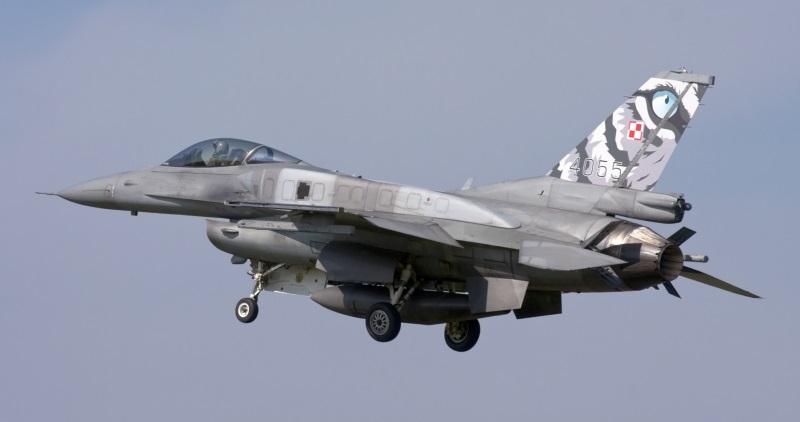
* Portugal obtained a total of 20 Block 15 OCU F-16A/Bs, including 17 F-16As and 3 F-16Bs, with initial deliveries in 1994 under the "Peace Atlantis" program. Portugal also received 25 ex-USAF machines later in the 1990s, including five spares hulks. 20 of this second batch, including 16 F-16As and four F-16Bs, underwent the MLU upgrade, with the first updated machine redelivered in the summer of 2003.
Portuguese F-16s have participated in air operations over the Balkans. Twelve MLU machines were sold to Romania in late 2013, including 9 F-16As and 3 F-16Bs, with deliveries in 2016 and 2017. Romania later obtained another 5 F-16s from Portugal, with deliveries in 2021 and 2022. At last notice, Portugal still had 25 F-16s, including three F-16As were sent by the USAF to Portugal in 2013, to be given the MLU update there. The 17 F-16s sent to Romania replaced Mikoyan MiG-21s. As noted earlier, the Romanians then obtained 32 hand-me-down MLU F-16s from Norway in 2022, with initial deliveries in 2023.
Slovakia ordered 14 F-16V Block 70 machines in 2018, to replace MiG-29s. The Slovaks obtained 12 single-seaters and two two-seaters, with deliveries to be in 2022 and 2023. Bulgaria obtained eight F-16Vs -- six single-seaters and two two-seaters -- towards a total buy of 16, to replace MiG-29s, with deliveries in 2023 and 2024.
Ukraine, as mentioned, is obtaining MLU machines from European users to help in its war with Russia, with Belgium, Denmark, the Netherlands, and Norway having pledged to send them so far, and first deliveries around the beginning of 2024. Ukrainian sources say they are being upgraded before delivery, but nothing was said about specifics. Presumably they will get software and possibly processor updates, and it seems very likely they will get the AN/APG-68(V)9 radar -- entirely current and well more capable than earlier AN/APG-68 variants.
BACK_TO_TOP* A number of Middle Eastern and North African countries are F-16 operators. Bahrain obtained 22 GE F110-powered Block 40 F-16C/Ds in the 1990s, including 18 F-16C single-seaters and 4 F-16D two-seaters, under the "Peace Crown I / II" programs. Bahraini F-16s flew defensive patrols during the first Gulf War. Ten more Block 40 F-16Cs were obtained in 2000.
Bahrain is now planning to obtain 16 F-16V Block 70 machines, with their older F-16s upgraded to a similar standard with SABR AESA radar, Link-16 datalink, and new cockpit displays. A new targeting pod and the latest munitions will be acquired as well. Initial deliveries will be in 2024.
* As a "reward" for signing the Camp David peace accords in 1979, both Egypt and Israel received the F-16, one of the most modern fighters the US had to offer. Egypt obtained a total of 240 F-16s in six batches through the "Peace Vector" series of programs:
Surviving early-block F-16s were upgraded to Block 42 standard in the late 1990s. Egypt has also obtained updated kit, including Sniper targeting pods.
* As for the Israeli F-16s, many of the initial aircraft were obtained from production originally slated for a deal with Iran that fell through with the Islamic Revolution. Four batches of F-16s totaling 260 machines were obtained under the "Peace Marble" series of programs:
The Israelis then obtained 102 "F-16Is", with deliveries from early 2004 to 2009. These are Block 60-class machines with conformal fuel tanks, modernized cockpit display systems, APG-68(V)9 multi-mode radar with SAR capability, and PW F100 IPE engines. With the delivery of F-16Is, the older F-16A/B machines became redundant, and the Israelis ended up selling some of them off to other nations -- with the last of them formally retired from service in late 2016.
In Israeli service, the F-16A/B became the "Netz (Hawk)", while the F-16C became the "Barak (Lightning)" and the F-16D became the "Brakeet (Thunderbolt)". Most Israeli F-16s had brake chute fairings -- though they were used to store combat avionics and not drag chutes -- and were painted in a distinctive sand-and-brown camouflage scheme, with Number 105 Squadron aircraft featuring a vivid sand-colored scorpion painted down the tailfin.
Israeli F-16s have featured a number of modifications and special fits. At least some of their Block 5 F-16A/Bs were fitted with improved countermeasures gear. All F-16Ds feature a dorsal spine like that fitted to the AFTI F-16, which was apparently used to house defense-suppression electronics and an Elta-built jammer. This "fatback" configuration appeared to use the back-seater as a dedicated "weapons system operator". Some Israeli F-16s have also been apparently fitted with Israeli-built ELta 2021B radar in place of the original US-built AN/APG-66 or AN/APG-68, and have been equipped with the Elbit DASH-4 helmet-mounted sight. Other new avionics are being incorporated as well to bring the fleet up to "Barak 2020" standards, in parallel with an airframe life extension program on the Block 30 machines.
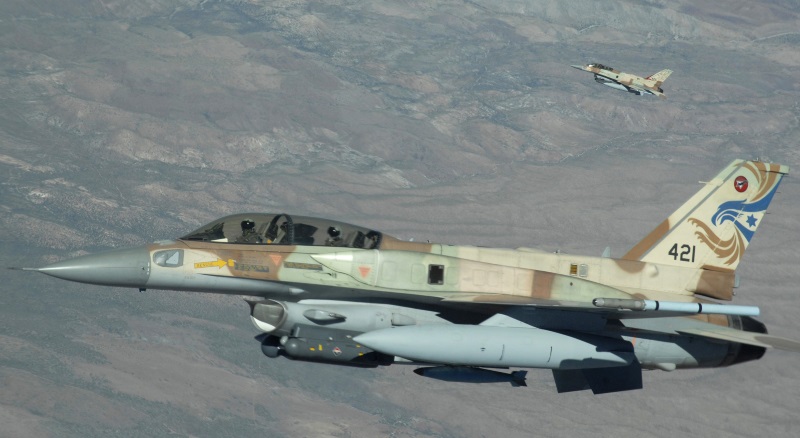
Of course, Israeli F-16s also carry Israeli-built external stores. Rafael Python heat-seeking AAMs are often carried in place of Sidewinders; Rafael Spice guided glide bombs have been qualified; and the Rafael Litening targeting pod is used for precision strike.
The Israelis have been one of the F-16's most enthusiastic users. In fact, the Israelis were often too enthusiastic for American comfort, and were the first to use it in combat. On 7 June 1981, eight F-16s staged a raid on the Osirak (Osiris-Iraq) nuclear reactor in Iraq, being built at Twartha near Baghdad. Israeli intelligence had determined that the facility was being built to synthesize plutonium for nuclear weapons. The raid was timed to take place when the reactor site was at its highest state of development prior to actually going on line.
The eight F-16s, with six F-15s providing top cover, cut across Jordanian and Saudi airspace at low level. They were fired on by Iraqi anti-aircraft batteries after entering Iraqi airspace, but the Iraqis scored no hits. The same could not be said of the Israelis, who plastered the site with unguided bombs and thoroughly wrecked it, caving in the reactor containment dome. The Israelis got back home without losses. The Reagan Administration protested the "military recklessness" of the raid, and suspended deliveries of F-16s for a time.
The Israelis have claimed a total of 47 kills with the F-16, mostly against Syrian MiG-23s during air fights over Lebanon in 1983:1984. One Israeli F-16s was said to have killed four MiGs on a single sortie. Israel is now obtaining the F-35 and gradually divesting itself of the F-16, with a dozen sold to Croatia in 2018, and 29 sold to Canadian "fighters for hire" training company Top Aces in 2021. These F-16s were upgraded with the Top Aces "Advanced Aggressor Mission System (AAMS)", a cross-platform "open architecture" system that integrates an AESA radar, helmet-mounted cueing system, IRST, tactical datalink, and EW subsystems.
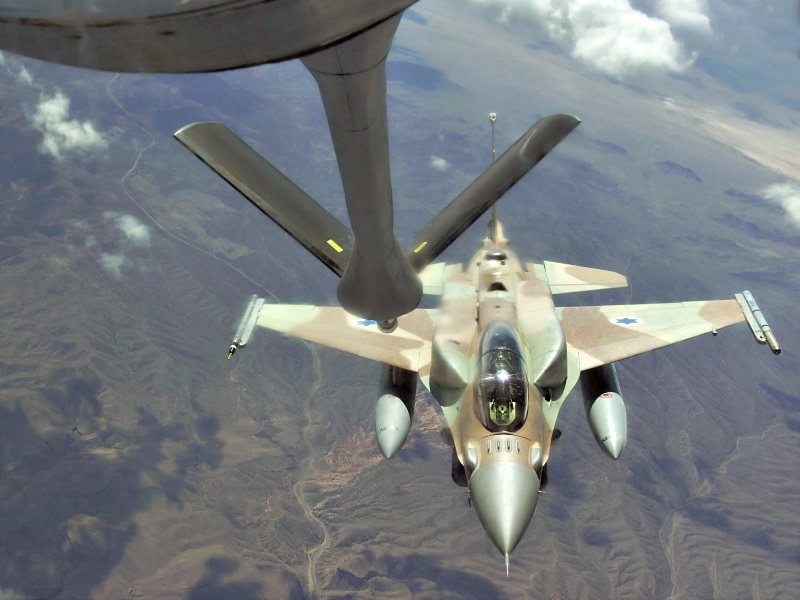
* In 1997:1998, Jordan obtained a batch of 16 hand-me-down US F-16s under the "Peace Falcon I" program. The shipment included 12 F-16As and 4 F-16Bs, all ADF variants. In 2003, they received 17 Block 15 F-16A/B ADF machines under "Peace Falcon II", including 16 F-16As and 1 F-16Bs, with these aircraft set aside to be put through the MLU update by Turkish Aviation Industries (TAI), with all redelivered by 2009.
In 2006, 8 more Block 20 MLU F-16Bs were bought from the Netherlands, along with 14 obtained from Belgium, with delivery of the machines from 2006 to 2008. They were promptly followed by 6 more Dutch F-16s, delivered in 2009, and 9 more Belgian machines, delivered in 2011; with Jordan obtaining 15 more Dutch F-16s in 2013, with final deliveries in 2017. As discussed later, in 2014 Jordan passed on a dozen Block 15 F-16As and one F-16B to Pakistan.
* The Turks are another major user of the F-16, having obtained a total of 270 F-16C/Ds beginning in the mid-1980s under the "Peace Onyx" series of programs. Eight were delivered from Fort Worth, with two more provided to TAI in kit form, and the rest built by TAI:
Turkish F-16s have performed peacekeeping duties in the Balkans, and as mentioned there are rumors of confrontations with Greek F-16s. Turkish F-16s are known to have shot down a Syrian Mi-17 helicopter in 2013, a Syrian MiG-23 in 2014, a Russian Su-24 in 2015, and another Syrian helicopter in 2015.
In 2005, Lockheed Martin obtained a contract to upgrade 100 to 200 Turkish F-16s to CCIP configuration -- with the Link-16 datalink system, the JHMCS sight, an improved BAE Systems SPEWS-II self-defense suite, and an improved AN/APG-68(V)9 radar. Lockheed Martin provided kits to TAI for upgrades "in country", with the first redelivery to the Turkish Air Force in 2011, the last in 2015. In early 2010, Lockheed Martin also obtained a contract to provide the Turkish Air Force with Sniper ATP targeting pods and LANTIRN ER navigation pods to provide Turkish F-16s with a updated precision intruder / strike capability.
Turkey had planned to obtain the F-35, but bad relations with the USA meant that deal didn't happen. As a result, the Turks are refurbishing their F-16s, providing them with a SLEP and systems improvements -- prominently support of Turkish-built munitions, and a new AESA radar designed by Aselsan of Turkey. The new radar will be fitted to other Turkish combat aircraft.
* As mentioned earlier, in early 2000, Lockheed Martin closed a deal with the United Arab Emirates for the sale of 80 Block 60 F-16s, including 55 F-16E single-seaters and 25 F-16F two-seaters. Initial flight of the first F-16F was on 6 December 2003, with initial delivery in May 2005 and final deliveries in 2007.
A second batch of 30 Block 61 machines was ordered in 2014, with survivors of the first batch to be brought up to a roughly comparable standard. The UAE's purchase of Block 61 F-16s appears to be on indefinite hold, but the upgrade of the Block 60s is still on track.
* The Sultanate of Oman, on the southern edge of the Arabian Peninsula, obtained twelve Block 52+ F-16s, including eight F-16Cs and four F-16Ds. They were fitted with F110-GE-129 engines. Deliveries began in October 2005, with last deliveries in 2006. Oman ordered ten more F-16Cs and two more F-16Ds in 2011, with deliveries to be completed in 2016.
* In 2008, Morocco ordered 24 F-16 Block 52 machines, with P&W F100 engines. There had been discussions with Morocco in the 1990s to obtain hand-me-down USAF F-16s, but the negotiations fell through. Morocco currently plans to obtain 25 Block 72 F-16s, and upgrade its 23 surviving Block 52 machines to F-16V standard.
* In 2011, Iraq ordered 18 F-16 Block 50/52 fighters, following up with a second order for 18 machines in 2012. 24 were single-seat F-16Cs, 12 were two-seat F-16Ds. The Iraqis also ordered a set of reconnaissance and Sniper pods. First deliveries were in 2015, having been delayed by Iraq's war with Islamic State insurgents; the F-16s were quickly put into action, performing strikes on IS positions. Deliveries were completed in 2019.
BACK_TO_TOP* Indonesia obtained a total of 12 Block 15 OCU F-16A/Bs, including 8 F-16As and 4 F-16Bs, with initial deliveries in 1989. They replaced MiG-21s in Indonesian service and were painted in a distinctive disruptive camouflage scheme. Indonesian F-16s feature drag chutes. Follow-up orders ran foul of political difficulties with the USA until 2011, when Indonesia inked a deal to obtain 24 ex-US Air National Guard F-16s -- 19 single-seaters, 5 two-seaters -- provided free of charge, with the Indonesians funding an upgrade, performed by the USAF, to a Block 52-type configuration. The first aircraft were delivered in 2014, with all delivered by the end of 2017.
* Pakistan originally obtained a total of 40 Block 15 F-16A/Bs, including 28 F-16As and 12 F-16Bs, with initial deliveries in 1983 under the "Peace Gate" program. Pakistan's F-16s saw a surprising amount of air combat during the Soviet war in neighboring Afghanistan during the 1980s. Soviet aircraft would often follow Afghan Mujahedin fighters fleeing over the border into Pakistan, and the Pakistanis would take them on. Pakistani F-16s claimed about a dozen kills. Apparently they also lost an F-16 to another F-16 in a "friendly fire" incident while in pursuit of an intruder; this may have been the first F-16 to be lost in air combat.
In the early 1990s, Pakistan was to receive 28 more Block 15 OCU F-16A/Bs, including 13 F-16As and 15 F-16Bs, but as mentioned earlier, the order was frozen in response to American worries about the Pakistani nuclear program. The 28 aircraft were mothballed in the "boneyard" at Davis-Monthan Air Force Base in Arizona. They were pulled out of storage in early 2003, with 13 of them provided to the USAF as test and evaluation machines, one of them transferred to the US Air National Guard, and as mentioned the remaining 14 transferred to the US Navy for use as aggressor aircraft.
Pakistan became a valued ally in the US "war on terror" that began after the 11 September 2001 attacks, and as a result the US eased up restrictions on arms sales. The embargoed order for 28 F-16s was made good with refurbished machines, and 18 Block 50/52 Plus machines were obtained as well, with deliveries from 2010 to 2012. From 2010, the fleet of older machines was updated to MLU standards by TAI, the last update being redelivered in 2014. Pakistan has also obtained a set of new ECM pods for their F-16 fleet.
Further reinforcement of the Pakistani F-16 fleet took place in 2014, when Jordan, as noted above, passed on 13 Block 15 machines, including a dozen F-16As and one F-16B. At the time of delivery, that gave, factoring in attrition, a total Pakistani F-16 fleet of 76 machines. In 2016, sales of eight Block 52 aircraft to Pakistan were announced, the batch to include six F-16Cs and two F-16Ds, bringing the total up to 84.
* Singapore obtained four batches of F-16s under the "Peace Carvin" series of programs:
Singapore has upgraded their F-16 fleet to F-16V standard, with the upgrade including such features as AN/APG-83 SABR AESA radar, JHMCS, new navigation and IFF modules, plus carriage of the latest munitions. No upgrade was planned of countermeasures systems; it seems the Singaporean F-16s had up-to-date Israeli countermeasures systems, mostly packaged into the fat spine. Lockheed Martin was awarded a contract for the upgrade program in late 2015, with upgrades beginning in 2016 and ending in 2023. The expectation is to keep the F-16s in service until at least 2030.
* The Republic of Korea (South Korean) Air Force (ROKAF) has acquired a large fleet of F-16s in two steps. The first step was fairly small, with the country obtaining a total of 40 Block 32 F-16C/Ds in 1986 and 1988, including 30 F-16Cs and 10 F-16Ds, under the "Peace Bridge / Victory Falcon" program.
In 1989, South Korea then considered a much larger fighter buy and decided to buy 120 F/A-18 Hornets, but the deal fell through and the government decided to buy 120 Block 52 F-16s instead. The initial 12 of this batch were supplied from Fort Worth, with the next 36 provided in knock-down kit form for assembly in South Korea by Samsung Aerospace, and the rest built by Samsung Aerospace. Initial deliveries of the South Korean Block 52 F-16s were in 1994, with the mix consisting of 80 F-16Cs and 40 F-16Ds. These machines were known locally as "KF-16s", and were fitted with the Northrop Grumman / ITT "AN/ALQ-165 Airborne Self-Protection Jammer (ASPJ)".
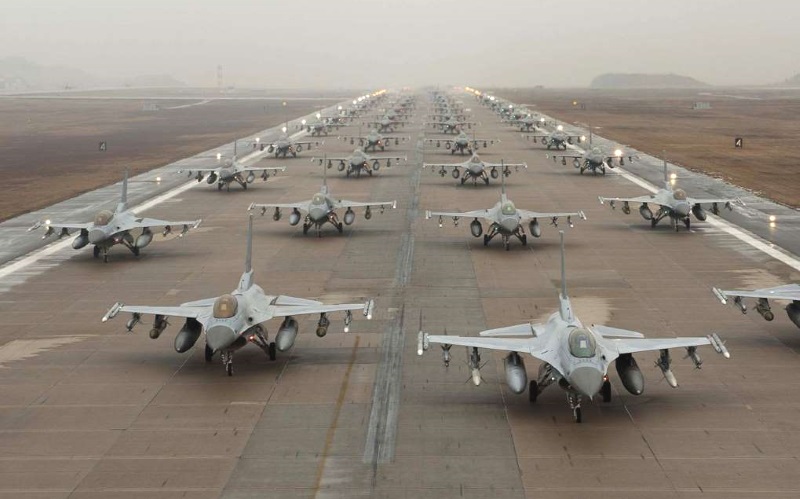
A follow-on order of 14 F-16Cs and 6 F-16Ds was placed in 2000, giving a total fleet of 180 F-16s. South Korea is working towards a major update of 134 of its F-16s, the centerpiece being an AESA radar, along with a general upgrade of avionics and munitions. A contract was awarded to BAE Systems, then canceled and restarted; Lockheed Martin won the award on the second round, in early 2016, with the SABR radar selected as the AESA. Further upgrade elements included the Link-16 datalink and a new IFF.
* Although the US cut off Taiwan from advanced arms shipments in the 1970s, the Americans gradually began to become less sensitive to mainland Chinese protests over arms sales. In 1992, the US government approved a sale of 150 F-16A/Bs to the island nation, with initial deliveries in 1997 under the "Peace Fenghuang" program. As mentioned earlier, these were in the form of the unique "Block 20", apparently more or less similar to the Block 15 MLU standard. The order included 130 F-16As and 20 F-16Bs. Taiwanese F-16s carry the AIM-7 Sparrow; apparently the Block 20 provided Sparrow support, while the Block 15 MLU did not, and the Block 20 also supported Taiwanese IFF.
While Taiwan later pressed for Block 60 F-16s, in 2011 the US decided to broker an F-16V Block 70-type upgrade program named "Phoenix Rising", to update 144 surviving F-16s, providing new avionics including:
Initial flight of the first upgraded Taiwanese F-16 was in October 2015, with initial redelivery in October 2018. They were the first F-16V-type machines to go into service. The first two were upgraded in the USA by Lockheed Martin, with the rest upgraded by Taiwan's Aerospace Industry Development Center. The last of 141 upgrades -- three F-16s had been lost to accidents -- were re-delivered in 2023. They were referred to as "Block 20 MLU" machines. Mainland China of course objected to the upgrade program, but the objections were perceived as muted; there would have been louder objections over the sale of Block 60 machines.
* Thailand has obtained a total of 61 F-16s, not counting two spares hulks, in several batches:
The Thais are upgrading their Viper fleet with AN/APG-68(V)9 radars and improved countermeasures systems. They have also armed their F-16s with German Diehl IRIS-T short-range AAMs.
* In 2021, the Philippines ordered 12 Block 70/72 F-16s, including 10 single-seaters and two two-seaters. There have been questions about the viability of the deal, since the purchase will impose severe strain on the country's budget.
BACK_TO_TOP* Venezuela obtained 24 Block 15 F-16A/Bs, including 18 F-16As and 6 F-16Bs, with initial deliveries in 1983 under the "Peace Delta" program. They had drag chutes, were at least originally painted in a two-tone brown-green jungle camouflage pattern, and were later put through the Block 15 OCU upgrade. Venezuelan F-16s fought in a coup attempt in 1992 in defense of the government.
In 2005, Venezuelan President Hugo Chavez tried to negotiate an upgrade program for the country's F-16s with Elbit of Israel. However, Chavez was a loud critic of the United States and the American government blocked the deal. Chavez threatened to give the F-16s to Cuba and China -- though neither country had any interest in them, knowing they would be a pain to support.
The only other Latin American nation to order the F-16 was Chile, which placed an order for ten Block 50 Plus machines in 2002 under the "Peace Puma" program. Deliveries were in 2005. The Chileans then, as mentioned, obtained 36 surplus Dutch F-16 MLU fighters, including 29 F-16As and 7 F-16Bs, with deliveries from 2006.
BACK_TO_TOP